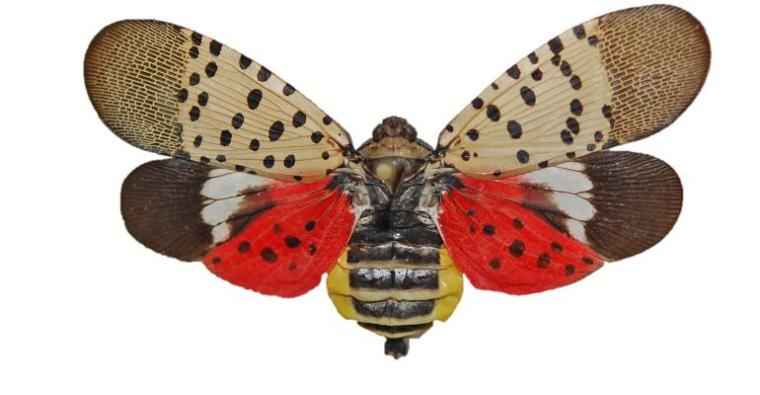Writer
Linda GeistCOLUMBIA, Mo. – An exotic pest that hitchhikes on train cars, trucks and boats could suck the life out Missouri crops.
Spotted lanternfly has the potential to establish populations in Missouri, says University of Missouri Extension field crop entomologist Kevin Rice. It damages soybean, corn and hops, as well as fruit and ornamental trees. According to MU Extension viticulturist Dean Volenberg, it could have damaging effects on Missouri’s 1,700 acres of grapes, its primary host.
Adult lanternflies are active in June and July. Entomologists reported seeing the spotted lanternfly in Pennsylvania in 2014. It has appeared since then in Virginia, Delaware and New York.
The plant hopper likes to lay its eggs on smooth, metal surfaces such as those found on train cars, boats and tractor-trailers. Its honeydew secretions attract other pests. It leaves weeping wounds as it feeds.
The adult lanternfly’s forewing is gray with black spots. The wingtips are black blocks outlined in gray. It has distinctive bright orange-red and white underwings, but it appears less vibrant and may be difficult to see when its wings are not spread, Volenberg says.
It likes fall feeding on Ailanthus altissima, also known as tree of heaven, a medium-sized invasive tree with stout branches that spread to form an open, wide crown. Its flowers are showy and fragrant and it tolerates drought. The tree also enables the ailanthus webworm moth.
What to do if you spot lanternflies
• Do not kill it. The insect contains cantharidin, the same toxic chemical found in the blister beetle.
• Capture it if you can. Lanternflies are jumpers.
• Take a photograph of it. Email to ricekev@missouri.edu.
• Collect a specimen and put it in a vial filled with alcohol to preserve it.
• Take it to your county extension center and note where you found it. GPS coordinates are helpful. The extension center will send it to Rice, who will track its spread in Missouri.
• Use caution when handling tree of heaven; its sap can cause headaches, nausea and possible heart problems, according to Penn State Extension.
Sign up for free pest alerts from MU Extension’s Integrated Pest Management program at ipm.missouri.edu/pestMonitoring.

